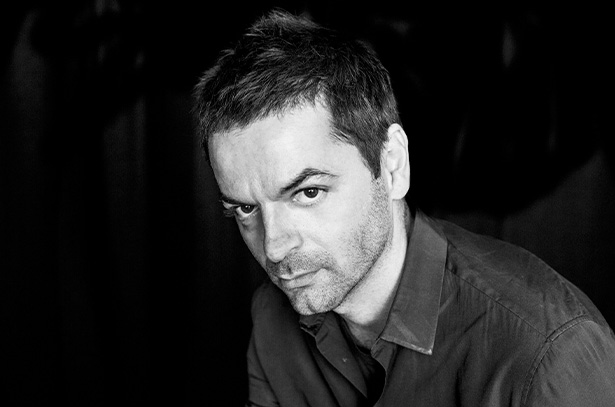
Anri Sala
3 June - 17 July 2004
London
"We are aware of the role that language plays in keeping our world together, it participates in the way we relate to each other, in the way we are polite to or tactless with each other, language subtitles, influences and restrains, it gives reality to the way we relate to the world….Sound is one step way from language…, but once you are in the street, most sounds are untamed, they are in the act of becoming. They are part of a language that is not yet controlled. And that is why I am interested in sound; it's like an incomplete music, this is where all music comes from." Anri Sala The first solo show of Albanian artist Anri Sala (b. 1974) at Hauser & Wirth Gallery in London presents two video works in which the artist further explores the treatment of sound in his work. On entering the main gallery space, the viewer is immersed in the soundtrack of Mixed Behaviour (2003). In Mixed Behaviour a DJ mixes tracks on a rooftop in Tirana, Albania on New Year's Eve, against the backdrop of the city's fireworks. He shelters from hard rain under a plastic canopy and the nocturnal setting reduces the body to a silhouette, shadows highlighted by the cacophony of colour and explosions in the orchestration overhead. The acts are interdependent, yet the DJ seems to actively manipulate the composition of fireworks, playing to and against the sky. The gallery’s Vault Room features Làkkat (2004) a video work that Anri Sala recently filmed in Senegal. Làkkat (one whose native tongue is different from the language of the place where he is) also plays with the treatment of sound through the repetition of words in Wolof spoken by Senegalese children. Sala explores the cultural and linguistic influences of Imperial colonisation and the words repeated are expressions of shades from white to black, in terms of both skin and light. The origins of the Wolof language are almost lost and Sala discovers the transformation of these words through a journey of cultural implications, into French (as seen at his show at ARC, Paris 2004), and into English (the words are subtitled). The effect of the childrens’ rapid articulations soon counteract any meaning, giving way to melodic intonations with subtle nuances and a rhythmic tempo; interjected by the camera’s shift to moths attracted to a neon tube. Sala’s interest in such transitions accentuates the relationship between language, sound, music; works within a temporal zone experienced through the senses. The above works are shot in partial darkness, creating abstract qualities and ambiguous space through impressions which extend beyond the frame. The latter is also seen in Sala’s new photographs of moths converging in ceiling corners, an area of limited light. The camera flash evaporates all shadows, leaving a striking image of moths tracing the structure of the space. Anri Sala possesses a unique sensibility in his work by juxtaposing elements of past and present, discordance and harmony, by overlapping narrative, sound and movement. Through film and video, Sala invites viewers to participate in his world of cultural observation and experiences and often uses socio-political settings as backdrops. However, the undercurrent is a fundamentally personal exploration of intimate, interwoven stories, resonating themes of a changing society and the individual. Anri Sala has shown his works in a number of international solo and group shows. He received the Young Artist Prize at the Venice Biennale 2001 and the Prix Gilles Dusein, Paris 2000, amongst others that include documentary and film awards. Sala’s work Dammi I Colori, shown at the Venice Biennale 2003, has recently been acquired by Tate Modern. Solo exhibitions include the recent Entre chien et loup (Cat.) at ARC Musee d’Art Moderne, Paris and Deichtorhallen in Hamburg (2004), the Kunsthalle Wien (2003), the Dallas Museum of Art, Texas (2002) and De Appel in Amsterdam (2000). Upcoming exhibitions of this year include Tate Modern and The Art Institute of Chicago in 2004.
About the Artist

Anri Sala
Anri Sala represents a truly contemporary international vision: working in a range of media including video, photography and installation, Sala was educated in Albania and France, but now lives and works in Berlin. In his films and installations, Sala invites viewers to participate in his world of cultural observation, for which he often uses socio-political settings and personal experiences as backdrops.
By juxtaposing elements of past and present, discordance and harmony, and by overlapping narrative, sound and movement, Sala creates a unique sensibility. With his first critically acclaimed experimental documentary ‘Intervista (Finding the words)’ from 1998, the artist formulates his interest in perception of reality, truth and historical transformation. Since then, his practice emerged into a study of sound—soundtracks of images, the absence of sound, or the failure of verbal communication, all form distinct kinds of narratives.
In 2001, Sala was the recipient of the Young Artist Prize at the Venice Biennale and in 2013, he exhibited his acclaimed video works ‘Ravel Ravel’ and ‘Unravel’(both 2013) for the French Pavilion. Both works analyze the perception of space through music—two versions of Ravel’s ‘Piano Concerto for the Left hand in D-major’ can be seen performed alongside each other. ‘Unravel’ sets out to sync what deliberately was paced out of sync; Chloé, a DJ and music producer, can be observed standing in the middle of the German pavilion trying to untangle what has been entangled in ‘Ravel Ravel.'
The undercurrent of Sala’s projects, such as ‘Intervista (Finding Words)’ or ‘Ravel Ravel Unravel,’ is a fundamentally personal exploration of intimate, interwoven stories, resonating themes of a changing society and the individual. The artist’s interest in transition and rupture is demonstrated by the way in which he relates language, sound, music. The impact of his work featured at the world's top venues and exhibitions endorses Sala’s conviction that art can transcend cultural references without losing any of its specificity, nor indeed, its power.
Current Exhibitions
1 / 12











